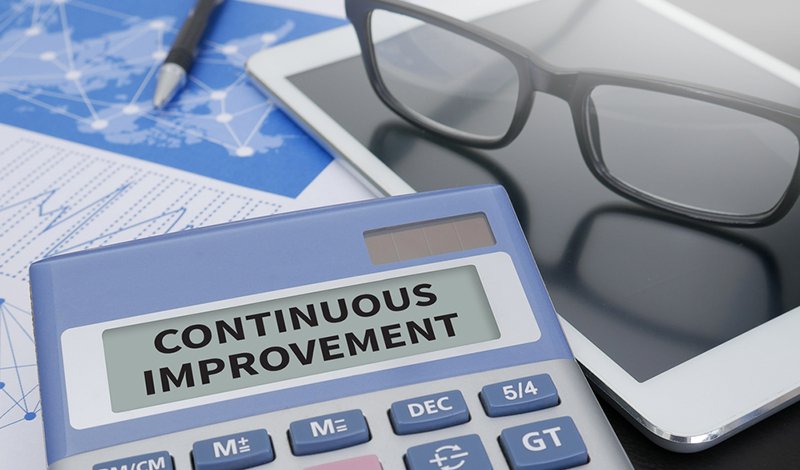How Does Standard or Actual Costing Drive Continuous Improvement for Manufacturers?

Part 3 of a 5-Part Series. Read Part 1, Part 2, Part 4, Part 5.
Standard versus actual costing is an important decision point for manufacturers. Synergy Resources’ Patricia ‘Pat’ Bumbaca, Katie Farrand and Jack Hughes share their insights on the issue to help manufacturers choose what may be best for their individual businesses.
Q: How does standard or actual costing drive Continuous Improvement?
Katie: The manufacturer can evaluate how they’re actually doing and compare against the standard. Let’s say you may have found a scenario where the labor was higher than planned. You’ve discovered that it’s taking twenty minutes longer than expected to work on every job. You can check to see if the cause was a defect in the latest batch of product that was received, for example, which may have resulted in rework on the floor; or some other problem. If you don’t spend the time to evaluate you won’t necessarily know how to set the target correctly.
Q: Can you give us another example?
Katie: Here’s another scenario. Let’s say that you are strategically planning a continuous improvement project. Obviously, you’d like to be able to make as much money as possible from what you plan to build.
You can evaluate by product volume or product code. Actual costing can help you look at where margins are coming from. You can say, ‘Let’s focus on the one product line where we can save the most money’. Actual costing information is very valuable with respect to planning your continuous improvement strategy.
Yet another example is supply chain. Sometimes buyers are tasked with winning price reductions: this is how much our price is at the beginning of the year and we’d like our buyers to see if they can bargain prices down. A good approach is to see if you can consolidate purchases; and when successful it means that you’ll need the ability to reset the standard on the Purchase Order line. As long as you have a snapshot in time – what number your buyers started with at the beginning of the year – then you can measure the price reduction that may or may not have been achieved from new material purchases.
The ability to take this approach is going to depend on the company. Some may have 100 suppliers where they really only need 50. The simple act of consolidating the best performing vendors can be beneficial. Often, if you double what you’re spending with an individual vendor you might be able to get a discount.
Q: It’s true that you might get a better price, but what about other analytics like on time shipment?
Katie: You have to look at aspects outside of costing, as well. You have to look at on-time delivery performance and select those suppliers who are not going to hurt you and the customers you serve.
Q: Does the actual cost analysis ever indicate an opportunity for Continuous Improvement?
Pat: There’s often room for Continuous Improvement. Consider a manufacturer who has very little labor applied to the assembly process. The manufacturer might reason, ‘I don’t want to capture the labor component because it’s inconsequential to me’. So we simply say, ‘Don’t do it. Put the labor cost into your burden. You’ve achieved the same thing’.
You have more flexibility in an actual cost database to respond more quickly to a fast-changing environment. When building something brand new, you don’t know what the standard is yet. Yes, you can see what happened with the materials going into your work order but they’ve already been sliced off the standard. If you’re using actual cost, you’re able to see the cost right away! Actual costing’s real-time ability is the reason why it wins out most of the time versus standard costing.
Q: Does Synergy Resources offer workshops to help manufacturers think through these kinds of issues?
Katie: Synergy Resources is very proud of our Continuous Improvement group – we facilitate strategic business planning, continuous improvement programs including Shop Floor and Business Process Kaizens. We offer a number of workshops to help manufacturers explore issues that might be raised by their analysis of standard and actual costing data. For example, we offer a supplier performance workshop. Current state and future state mapping can help the manufacturer develop a program for supplier performance. We can also help the customer implement the solution by putting the measurements and metrics in place. Typically, we structure the program so that the customer can critically assess their suppliers across the board.
Synergy Resources can also help with inventory reduction efforts. We’ll take a similar approach where we’re starting with a snapshot of the standard cost. We use this information to help the manufacturer properly set factors that drive inventory levels in parts maintenance, for example. We want to understand how frequently the manufacturer should be buying parts and materials, and at what volume. Having accurate standards in place can help the manufacturer make sure they’re not bringing in too much inventory, to soon before they need to use it.
About the Experts
- Patricia ‘Pat’ Bumbaca has worked for Synergy Resources since 1999. Pat specializes in financials and accounting process improvements.
- Katie Farrand has worked in the Continuous Improvement group at Synergy Resources for the past six years. Katie specializes in helping customers improve business performance through the implementation of process improvement strategies.
- Jack Hughes is a CPA who joined Synergy Resources in 1998. Jack specializes in financial software applications and business process consulting.


